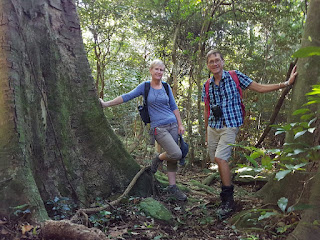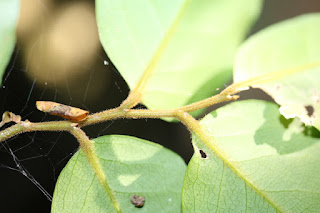Some days are days that have hiccups and minor
challenges that come one’s way but they can be overcome with humour, calmness
and a lot of cheery songs in the car as one navigates to find a place to
botanise as Simon had joined us and with his love for trees a forest was on our
radar. With no access into closed gates into
the Umtumvuna Reserve we ended up on a private farm near Red Desert and Beaver
Creek.
With forests comes spiders, plentiful and large in all shapes and sizes. The stream ran through the giant trees and Anne and Tracy skipped ahead to ring bark alien invasives whilst Dorothy taught us how to identify trees. We nibbled on the fruits of Cryptocarya wyliei and then browsed on the Embeilia ruminata which was an acquired taste, a little like Portulacaria afra perhaps - sour! After nestling down in a cluster of trees in the shade to have our lunch we set off again up into the grass land where we found ourselves rather bogged down to say the least. The earth was so wet and squelchy that had one been a pig one would have been very happy and at home. There on the slopes we found the endangered Helichrysum pannosum, not spectacular in the least. The Morea stricta literally opened up their candle like heads at two o-clock to show their faces in the late afternoon sun. We dipped back into the forest, where the boulders were huge and the trees were so old and tall. Huge Encephalartos natalensis and Stangeria eriopus grew here.
We had all left in good spirits and found
ourselves back in the car singing away.
 |
| Stangeria eriopus ZAMIACEAE |
 |
| Debbie in the "Spook Huis" |
 |
| Drypetes gerrardii var. gerrardii - Forest Ironplum PUTRANJIVACEAE Sexes separate, on different trees. Branchlets and buds with fine, yellowish or brownish hairs. Larval food plants for butterflies Appias sabina phoebe and Coeliades libeon. |
 |
| Mitriostigma axillare - Dwarf loquat RUBIACEAE |
 |
| Psydrax obovata subsp. obovata - Coastal Pioneer Quar RUBIACEAE |
 |
| Capparis fascicularis var. fascicularis - Zigzag Caper bush BRASSICACEAE |
 |
| Gomphocarpus physocarpus - Balloon Cottonbush APOCYNACEAE |
 |
| A Praying Mantis. |
 |
| Lasiosiphon anthylloides THYMELAEACEAE |
 |
| Photo credit: Debbie King |
 |
| Moraea stricta IRIDACEAE This Moraea opened up twenty minutes before its scheduled time. When it's 2 o'clock they open up and show their beautiful faces. |
 |
 |
| Helichrysum pannosum ASTERACEAE Endangered A2c Justification: A population reduction of at least 50% is estimated based on 55.4% habitat loss in the past 90 years, mainly due to cultivation of sugarcane and other crops, urban and coastal development and alien plant invasion, and it is suspected to be locally extinct north of Durban due to more than 90% habitat loss in that part of its range. The generation length of this resprouting grassland forb is estimated to be 30 years. Although still fairly common in remaining suitable habitat, this species is expected to continue to decline as a result of ongoing habitat loss and degradation. - Sanbi's Red List |
 |
 |
| Athrixia phylicoides - Bush Tea ASTERACEAE |
 |
| Perched on top of rocks escaping the bog. It looks a lot like social distancing but it wasn't. |
 |
| Helichrysum natalitium ASTERACEAE |
 |
| Dissotis canescens MELASTOMATACEAE |
 |
 |
| Helichrysum decorum ASTERACEAE |
 |
| C.R.E.W. stomping about in the wet marshland. |
 Pavonia columella - Pink Pavonia MALVACEAE |
| Photo credit: Debbie King |
 |
| Coddia rudis - Small Bone- apple RUBIACEAE The plant is browsed by game and stock. |
 |
| Embelia ruminata - Bitter Leaf MYRSINACEAE Edible but sour tasting leaf. |
 |
| Cryptocarya wyliei - Red Wild-quince LAURACEAE Edible fruit. |
 |
| Grewia hispida - Drakensberg Raisin MALVACEAE |
 |
| Polygala virgata var. virgata - Purple Broom POLYGALACEAE |
 |
| Tracy and Anne ring barking Camphor trees, the alien invasive. |
 |
| Allophylus dregeanus - Simple leaved False Currant SAPINDACEAE Flowers in Autumn. Larval food plant for butterfly Charaxes varanes varanes. |
 |
| Scolopia zeyheri - Thorn Pear SALICACEAE Robust spines up to 200 mm long. Leaves laves lanceolate to almost circular. The wood is very hard, and once used in wagon making in in the manufacture of teeth for mill wheels. |
 |
 |
| Empogona lanceolata - Jackal-coffee RUBIACEAE |
 |
| Celtis africana - White Stinkwood ULMACEAE Mature tree |
 |
| Celtis africana - White Stinkwood ULMACEAE Young sapling Widely planted as shade tree in gardens, parks and along streets. Larval food plant for butterflies. |
 |
| Drypetes arguta - Water Ironplum PUTRANJIVACEAE Sexes separate, on different plants. Edible fruit, used to brew beer. Wood used for carrying-sticks and in hut building. |
 |
| Cnestis polyphylla - Itch Pod CONNARACEAE |
 |
| Cnestis polyphylla - Itch Pod CONNARACEAE Immature leaves are red, ranging through bronze, pale green, mid-green to bluish-green when mature. The seed capsules are covered inside and out with rigid reddish-brown hairs which penetrate human skin with ease and cause intense itching. |
 |
| Bersama swinnyi - Coastal White Ash MELIANTHACEAE |
 |
| Bersama swinnyi - Coastal White Ash MELIANTHACEAE The bark is used in traditional medicine. |
 |
| Photo credit: Dorothy. Alf in the forest. |
 |
| Debbie having an urge to hug this tree. |
 |
| Pondoland C.R.E.W. Debbie King, Alf Hayter, Anne Skelton, Gail Bowers-Winters Tracey Taylor, Dorothy McIntyre and Simon Hicks |
“Ancient trees are precious. There is little else on Earth that plays host to such a rich community of life within a single living organism.” — Sir David Attenborough

















